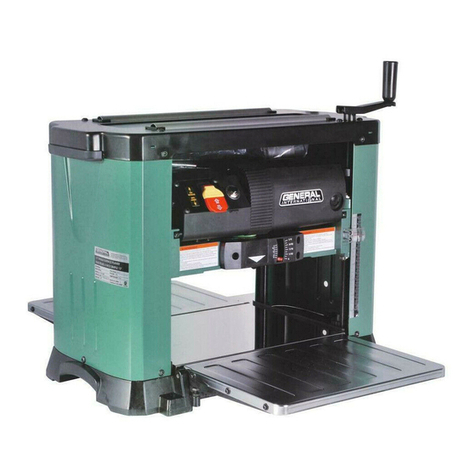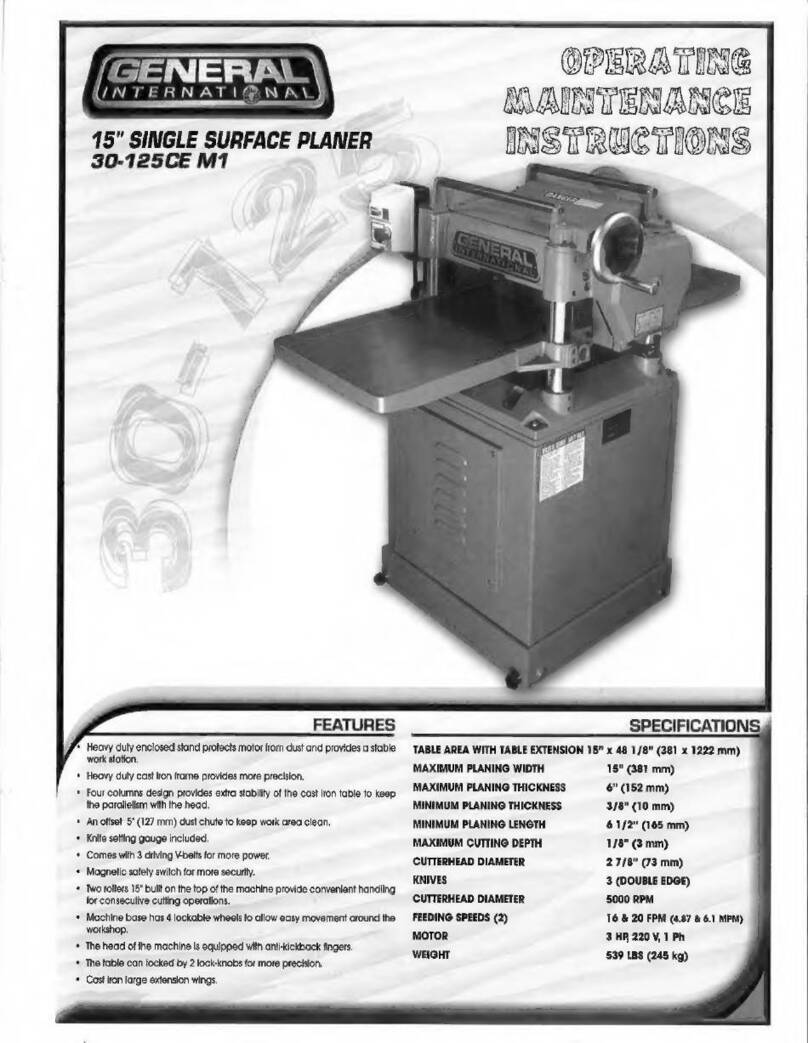1. Read, understand and follow all safety warnings and
instructions in the supplied Operator’s Manual.
2. Do not operate the planer when tired, distracted, or
under the effects of drugs, alcohol or any medication
that impairs reflexes or alertness.
3. The working area should be well lit, clean and free of
debris.
4. Keep children and shop visitors at a safe distance
when the planer is in operation; do not permit them to
operate the planer.
5. Childproof and tamper proof your shop and all ma-
chinery with locks, master electrical switches and
switch keys, to prevent unauthorized or unsupervised
use.
6. Stay alert! Give your work your undivided attention.
Even a momentary distraction can lead to serious
injury.
7. Wear approved safety glasses, dust mask and hearing
protection, and do not wear loose clothing, gloves,
bracelets, necklaces or jewelry while operating the
planer. Wear protective hair covering to contain long
hair and wear non-slip footwear.
8. Fine particulate dust is a carcinogen that can be ha-
zardous to health. Work in a well-ventilated area and
whenever possible use a dust collector.
9. Keep hands well away from the cutterhead and all
moving parts. Do not clear chips and sawdust away
with hands, use a brush.
10. Be sure that wrenches, tools, drinks and other clutter
are removed from the machine and/or the table sur-
faces before operation.
11. Kickback is when the workpiece is ejected at high
speeds by the force of the cutterhead. To minimize the
risk of injury from kickback, use proper feeding tech-
nique and stand to one side, out of the path of a po-
tential kickback.
12. Be sure the blades are securely installed in the cutter-
head and in proper cutting direction before operation.
13. Make sure the cutterhead has gained full operating
speed before feeding stock into the planer.
14. Always use clean, properly sharpened knives in the
cutterhead. Dirty or dull knives are unsafe and can
lead to accidents.
15. Inspect stock and remove all foreign objects before
planing. Make sure that any stock you plane is clean
and free of dirt, nails, staples, tiny rocks or any other
foreign objects that may damage the blades. Only
process natural solid wood boards. Never plane MDF,
particle board, plywood, laminates or other synthetic
materials.
16. Do not push or force stock into the cutterhead. The
planer will perform better and safer when working at
the rate for which it was designed.
17. The maximum depth of cut for one pass is 1/8” for a
board of 5 -1/2" or less In width and 1/16" for a board
wider than 5 -1/2". Never attempt to remove more ma-
terial than the maximum in any single pass.
18. Select appropriate feed speed for the stock being pla-
ned: high speed for softwood and slow for hardwoods.
19. Place stock firmly against the table and use suitable
in-feed and out-feed support if stock is too long.
20. Keep guards in place and in working order. If a guard
must be removed for maintenance or cleaning make
sure it is properly attached before using the machine
again.
21. Never leave the machine unattended while running
or with the power “ON”.
22. Always turn off and disconnect from power source
before servicing or changing accessories, blades, or
before performing any maintenance or adjustments.
23. Make sure the switch is in the "off" position before plug-
ging in the power cord.
24. Make sure planer is properly grounded. If equipped
with a 3-prong plug it should be used with a three-pole
receptacle. Never remove the third prong.
25. Use only parts and accessories that are designed for
use with this planer. The use of parts or accessories
NOT recommended by General International may re-
sult in equipment malfunction and an increased risk
of injury.
26. Do not use this planer fro anything other than its in-
tended use. If used for other, General International
disclaims any real or implied warranty and holds itself
harmless for any injury which may result from that use.
Rules for Safe Operation
To help ensure safe operation, please take a moment to learn the machine’s applications and limita-
tions, as well as potential hazards. General® International disclaims any real or implied warranty and
holds itself harmless for any injury that may result from improper use of its equipment.































